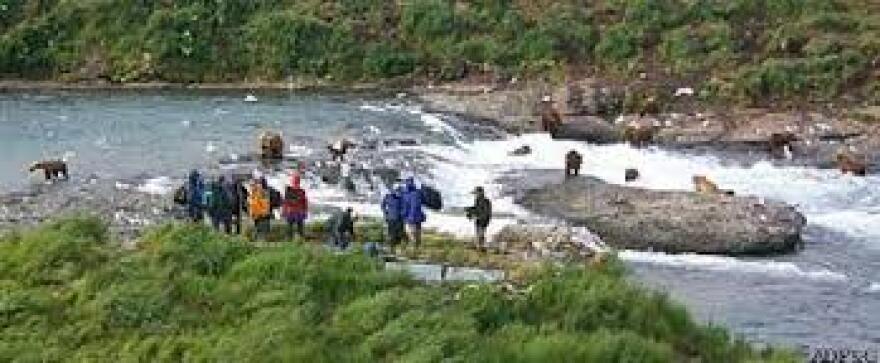Most of the arguments against the proposed Pebble mine in Bristol Bay center on the region’s world class salmon fisheries. But other wildlife concerns are getting some attention, too, as the project’s draft environmental impact statement continues to receive scrutiny.
A new study from the University of Alaska Fairbanks is adding some fuel to the debate over the Pebble mine. The study looked at bear viewing, as an industry.
Drew Hamilton of Homer guides tourists for such excursions across Cook Inlet, where the bears are plentiful and the plans for some of Pebble’s operations have people nervous. Hamilton spoke to a joint meeting of the Kenai and Soldotna Chambers of Commerce.
“There’s this huge complex that’s full of bears; protected areas, Lake Clark National Park, you’ve got the McNeil River State Game Sanctuary and Refuge which is the largest congregation of brown bears anywhere on earth. The most bears I’ve seen in a quarter mile stretch of river there at one time was 78. And then you’ve got Katmai Park and Preserve.”
All those bears draw lots of tourists, especially for such a remote area. According the UAF study, the number of visitors to Lake Clark has doubled twice in the last decade and now, more of those 17,000 tourists are interested in seeing bears than sportfishing. That all adds up to an industry generating more than $30 million in sales a year and providing nearly 500 jobs.
But that little spot in the world is also where some major mining operations could go. The ore that comes out Pebble will travel across Lake Illiamna, then be trucked on a yet-to-be-built 38 mile road that will take it to tidewater for shipping.
“One of the things that hasn’t been looked at...we’re already talking about this road corridor. They’re going to be sending these big trucks up and down this road all the time. It’s right along the migration corridor. And we in the bear viewing industry need consistency and numbers to be able to go out and see bears. You don’t want to hop in your plane and fly from Homer and go around and search for them. You want to know where you’re going before you get in that plane. It’s going to interrupt denning habit, it’s going to interrupt migration patterns and honestly, bears and roads just don’t mix.”
Hamilton works with a group of guides called the Friends of McNeil River and their main complaint about this draft environmental impact statement on the mine is that it doesn’t include them. He says studies about what that 38 mile road would do only extend out three miles from the corridor. That’s not much distance for a brown bear to cover.
“These bears will go 60-80 miles, one bear that was tagged went 100 miles. So if you’re only studying within three miles of the affected areas, you’re not going to get a good picture. And as somebody whose livelihood relies on these bears, that’s not something I’m willing to tolerate for a project that’s this size, this scope and (has) this potential amount of destruction.”
Another concern with a possible influx of workers and activities is the potential for more DLP incidents; bears killed in defense of life or property or even habituating bears to humans just being around making it more dangerous for the designated viewing sites used by tourists. The public comment period on that draft environmental statement was recently extended and the U.S. Army Corps of Engineers is accepting comments until the end of June.
Next month, local chambers of commerce will host representatives from the Pebble Partnership to discuss that side of the issue.

